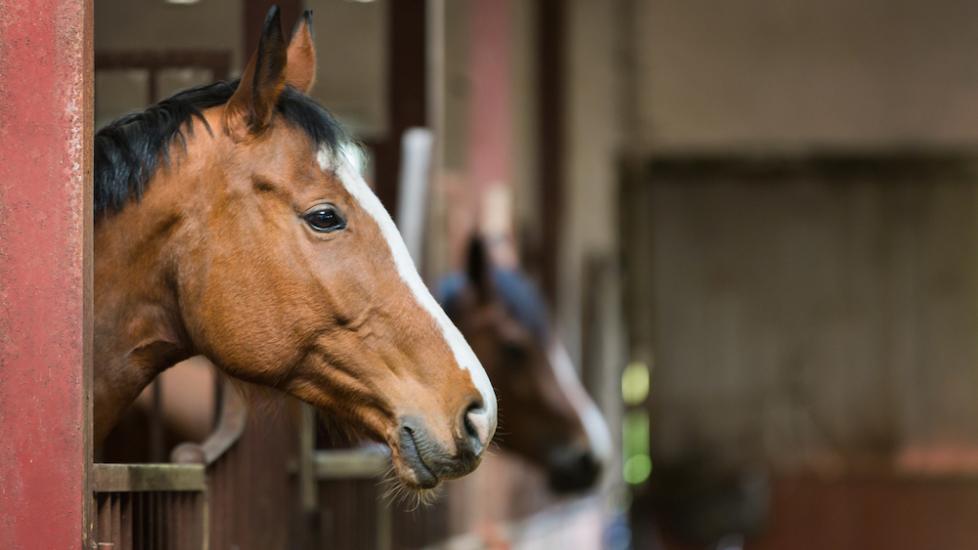Horse First Aid Kit
While horses are beautiful creatures that give us immense joy, their natural curiosity mixed with their fight-or-flight response tends to land them needing medical care quite often.
Anyone that has owned a horse knows that at some point your horse is going to find a way to get hurt or injured. Having a properly supplied and easily accessible first aid kit can not only be crucial but also help ensure your horse’s safety until your veterinarian can be reached.
Common emergencies in horses may include:
First Aid Kit for Horses
A good equine first aid kit should include:
-
Your vet’s phone number: always call your veterinarian with any type of equine emergency
-
Thermometer
-
Gloves
-
Non-stick telfa pads
-
White gauze roll or cast padding
-
Combine Redi-Rolls or sheet cotton
-
Brown gauze
-
Vetwrap
-
Elastikon
-
Hydrogen peroxide
-
Saline
-
Chlorhexidine or betadine solution (always dilute with bottled water before using)
-
Rubbing alcohol
-
4x4 gauze sponges
-
Bandage scissors
-
Epsom salt
-
Diapers
-
Duct tape
-
Hoof pick
-
Clippers
-
Scissors
-
Antimicrobial skin or wound spray/salve (Vetercyn spray or Fura-zone)
-
Small flashlight with batteries
-
Prescription medications such as Banamine (flunixin meglumine) or Bute (phenylbutazone) are great medications to have on hand in cases of emergency of colic or lameness. Before giving any medication, always contact your veterinarian to make sure this is the recommendation for your specific emergency.
Your first aid kit should always stay with your horse. Whether your horse is boarded or at your own barn, a first aid kit should be kept close by or in the barn in a clean, dry place. If you are traveling with your horse, your first aid kit either needs to be portable and go with the horse or you should make a second kit to keep in your trailer.
Medications & Supplements
Depending on the lifestyle of you and your horse, there may be medications or supplements that you should keep on hand to use as needed. It is recommended to discuss these with your veterinarian to decide which are the best fit for you and your horse.
-
NSAIDs (non-steroidal anti-inflammatories): Bute or Banamine
-
Electrolyte paste to treat dehydration: these are especially good for horses competing in hot climates or for long periods of time such as endurance riding
-
Sedatives: Oral sedatives such as Dormosedan gel may be helpful in certain situations
-
Triple-antibiotic eye ointment: may be recommend in certain situations
-
Gastric ulcer preventive: This may be useful for horses that are at risk for gastric ulcers due to their lifestyle (traveling, competition) or at higher risk
When to Contact Your Veterinarian
If you have any concern about your horse, your first call should be to your veterinarian. They will be able to help advise you in an emergency and how to monitor and use your first aid kit until they arrive.
How to Check Your Horse's Vital Signs
When you are assessing your horse to look for anything abnormal, there are a few vital signs or measurements of your horse's most basic functions you can check:
-
Heart rate (pulse): 28-44 beats per minute is normal
-
Respiratory rate: 10-24 breaths per minute is normal
-
Temperature: 98-101.5 F is normal
-
Gum color: should be moist and pink
-
Skin tent: usually quickly snaps back into place within 1.5 seconds
How to Check a Horse’s Heart Rate
If you have a stethoscope, place the stethoscope on the left side of the horse behind the left front leg where the girth would be.
If you do not have a stethoscope, then you can feel a pulse with two fingers under the jaw (maxillary artery) or below the fetlock (digital artery).
Once you have found the pulse, count for 30 seconds and then double your count to give you beats per minute.
How to Check a Horse’s Respiratory Rate
To check a horse's respiratory rate, you should look at their flank and count the number of breaths in and out for 30 seconds and then multiply that by two to get breaths per minute.
How to Take a Horse’s Temperature
A horse's temperature is taken by putting a small amount of lube on the end of a digital thermometer. The digital thermometer is placed inside the rectum. Make sure to keep a hold of the thermometer the entire time.
It is also important to stand in a safe position while inserting and holding onto the thermometer, the left side of the horse against their side/hip is the best location. Do not attempt in a horse that is fractious or tends to kick.
How to Check a Horse’s Gum Color
To check gum color, gently lift your horse's upper or lower lip and look at the gum above or below their teeth. It should be moist and pink.
How to Check for a Skin Tent
A horse’s skin tent is generally taken by gently pinching up on their skin, usually on their neck. When you release the skin it should fall back into place within 1.5 seconds. If it does not and remains “tented” for 3 seconds or longer, this could be a sign of dehydration.
By having the right items available in a first aid kit–ensures that you’re always ready for any emergency–big or small–that may happen to your horse.
Featured Image: iStock.com/castenoid
